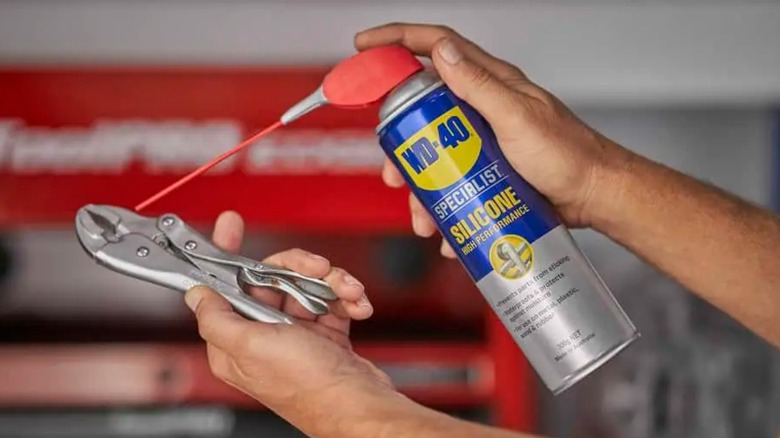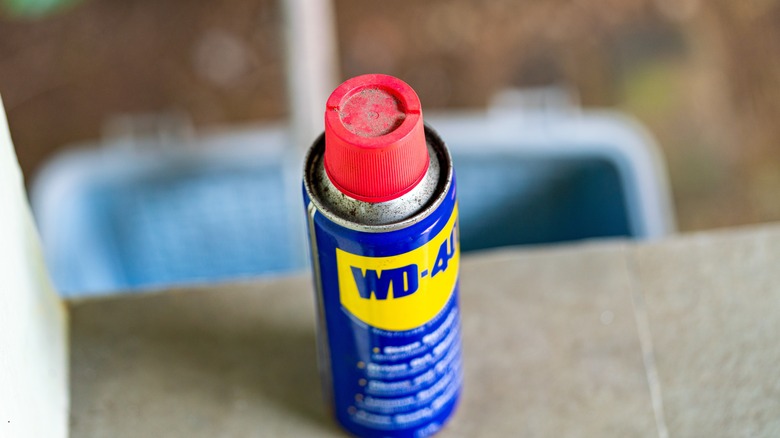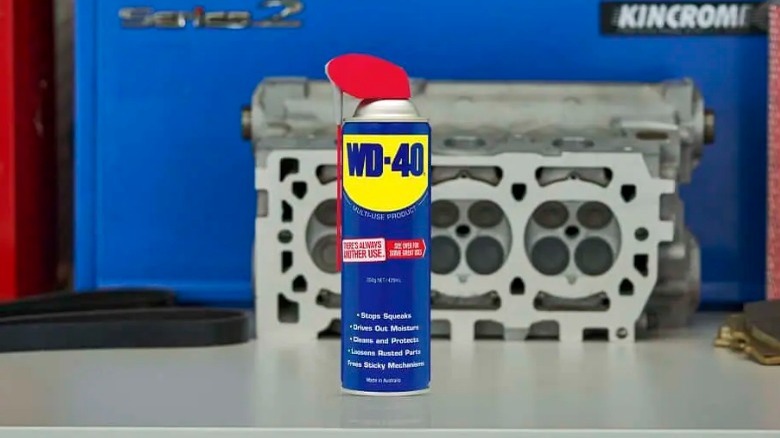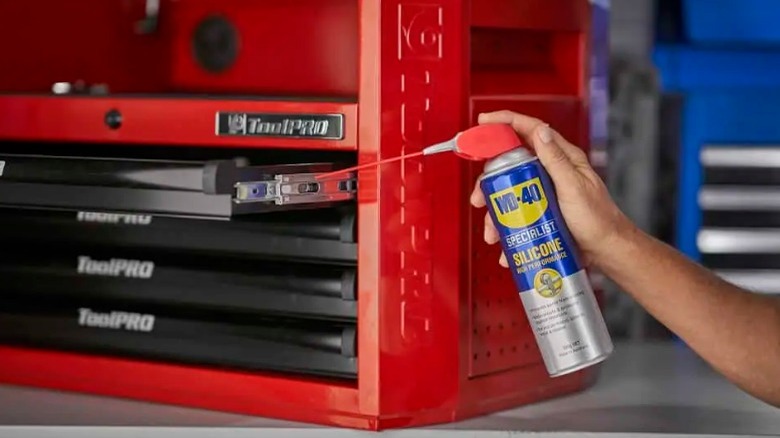WD-40 Vs. WD-40 Silicone: What's The Difference And Where Should You Use Them?
When you hear the name "WD-40," the first thing that comes to mind is probably the company's original, Multi-Use Product. The brand name has become so synonymous with this particular compound that it's commonly used as shorthand, like calling a tissue a Kleenex. This isn't the only formula that WD-40 makes, however. The company has several different liquid and aerosol compounds in its catalog, and each of them is designed to work in very specific circumstances.
One of the most popular of these alternative products that WD-40 makes is its Specialist Silicone spray. The original WD-40 Multi-Use formula has a lot of different uses, but that doesn't mean that it's the best tool for every job. There are some situations where the silicone formula will make for a much more effective alternative. That said, it can sometimes be difficult to determine which spray is best suited for a given job if you aren't aware of what they are and how they work. Here is a quick breakdown of the main ingredients in the two formulas and what kind of jobs they are best suited to.
Multi-Use vs. Silicone formulas
The complete WD-40 Multi-Use product formula is a carefully guarded trade secret, but it mostly comes down to three ingredients: Petroleum base oil, aliphatic hydrocarbon, and carbon dioxide. The CO2 is basically just there to pressurize the can and doesn't really contribute to the formula's effectiveness. The petroleum base oil is essentially mineral oil. It has mild lubricating properties but is most often used in wood conditioning and the cleaning of machine parts. The aliphatic hydrocarbon makes up a little more than half of the can's total contents. This is what gives WD-40 its degreasing properties. It is a petroleum-based solvent, like what you might find in gasoline or kerosene, and it's also the main ingredient responsible for most of the potential health risks associated with WD-40.
The WD-40 Silicone formula is also composed of three primary ingredients, similar to those found in the Multi-Use formula, but different enough that they serve entirely different purposes. It is made of LVP petroleum solvent, Polydimethylsiloxane (aka silicone polymer), and a blend of propane and n-butane which is used as the can's propellant. Starting with the LVP solvent, LVP stands for low vapor pressure. This solution primarily serves as a vehicle to carry the silicone polymer, though it is also a member of the aliphatic hydrocarbon family, and shares many of the same cleaning and degreasing properties. Then there is the silicone itself, which serves as a heat-resistant lubricant for machine parts.
Best applications for WD-40 Multi-Use
There are, frankly, a ridiculous number of applications for the original WD-40. Go on any DIY forum, and within minutes, you'll hear someone announce a new use for the spray that you have never even considered before. There are dozens of hacks involving the original formula, with people suggesting that it's good for everything from breaking in a baseball mitt and unsticking zippers to cleaning crayon off the wall and keeping bugs and spiders from crawling in the gaps around your windows.
However, a few primary applications are the main reasons you will probably want to keep a can of WD-40 handy. As the ingredients suggest, WD-40 makes for an excellent degreaser. This makes it a handy product to have in the garage if you ever need to clean automotive parts or gunked-up tools. It's also a garage essential for removing rust and protecting metal surfaces from oxidization. This means you can use it to restore old tools and protect new ones, break free stuck hinges, break free stuck fasteners, and remove corrosion from old blades. You can use it to polish metal surfaces and clean out the narrow gaps that are difficult to reach through mechanical methods. It's also good for displacing water that has settled inside of delicate machinery. But contrary to popular opinion, there are some things that WD-40 can't do.
Best applications for WD-40 Silicone
As mentioned before, WD-40's Multi-Use formula is oil based and therefore has some mild lubricating properties. This is usually good enough in a pinch for simple hinges and other basic mechanisms, but it's a far cry from the best option out there. It certainly isn't meant to be a long-term solution for complex machinery.
WD-40 Specialist Silicone is a much better lubricant than regular WD-40. The silicone polymer creates long-lasting lubrication that significantly reduces friction in both metal and non-metal moving parts. This makes it a better product to use on the same hinges, chains, and drawer sliders that you might use regular WD-40 on, but it's also a better lubricator for lift mechanisms, door locks, latches, hoists, pulleys, belts, conveyors, and other, more complex mechanisms. The belt roller on a treadmill, for instance, is a rapidly moving part that might build a significant amount of friction over time. WD-40 silicone spray can lubricate these moving parts, providing an efficient and long-lasting solution.
The silicone spray is water resistant, making it great for mechanisms exposed to the outdoors, such as gate hinges and latches, or the hinges on your car or truck. It's also much more resistant to extreme temperatures than regular WD-40. This protective layer is also particularly good on plastic and rubber components. This means that can prolong the life of plumbing parts, plastic seals and washers, door and window seals, as well as rubber pipes and hoses.



